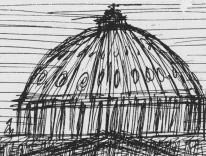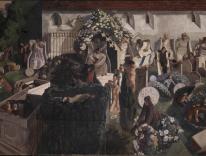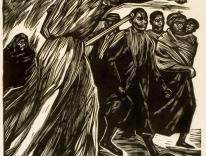No one is as effective as Andrew Greeley when it comes to using survey data in a street fight. In Priests: A Calling in Crisis, he’s armed and has some points about the priesthood he’d like you to understand.
Greeley, of course, is as angry as the rest of us about the damage inflicted on the church by pedophilia-related scandals and cover-ups. What he’s upset about in this book, though, are the pat, unsupported explanations of it all he sees coming from prominent Catholics who, well, simply don’t have the facts. As a result, they’ve maligned priests generally and celibacy in particular, and ignored the real causes of what has dragged down the priesthood.
Greeley, with scores to settle, is both entertaining and relentless. If you want him to name names, he’s happy to. They include A. W. Richard Sipe (widely cited author of many studies of the priesthood, including the recent Celibacy in Crisis: A Secret World Revisited); Eugene Kennedy, Greeley’s former fellow priest in Chicago and a frequent commentator in the popular press; and several other authors and observers of the Catholic scene. Although they may have a few good points, Greeley feels they’ve used flawed data, or in some cases no data, to spin a fallacious conventional wisdom about the priesthood: it’s filled with repressed, unhappy, emotionally immature men, the best of whom would leave, come out of the closet, or get married if they had the gumption. Celibacy may not itself be the direct cause of pedophilia in this view of the world, but it ends up looking awfully suspect.
In response, Greeley marshals not only his oft-cited National Opinion Research Center (NORC) survey data but an in-depth study of the priesthood conducted in 2002 by the Los Angeles Times. Most current priests, he claims, aren’t miserable as celibates, and they’re no more emotionally immature than most men. (Depending on your view of men generally, that’s reassuring.) It’s far from the case, he concludes, that “all the good ones leave.” Many priests still take pride in their work and find it rewarding, and the vast majority would choose the priesthood if they had it to do over again. Priests who leave, in Greeley’s often convincing interpretation of the data, are driven out not by the requirement of celibacy, but because they ultimately didn’t like the work.
Yet, even assuming that priests who remain priests aren’t as miserable or dysfunctional as some imagine, what about the future? Here Greeley has a hard time presenting a picture any more optimistic than the Cassandras he criticizes. He’s aware that some of these “satisfied” priests may simply have settled into a relatively agreeable life (as many of their middle-aged lay counterparts have), and he’s understandably at a loss to explain the disjuncture between priests’ high satisfaction with their work and the laity’s documentably low opinions of their preaching and ministry. What’s more, his data does support one current stereotype of the priesthood: the emergence of a smaller but more clerical, less flexible new generation of priests, slightly less supportive than their seniors of everything from the ordination of women to the election of bishops.
Is celibacy then ultimately the problem? Greeley suggests it may be the primary reason young people aren’t attracted to the priesthood, although on this topic he doesn’t have data to back him up. He points out that a married clergy hasn’t worked magic for mainline Protestant denominations, which face their own challenges of recruitment, compensation, and lamentably low job satisfaction. Of course, the priesthood’s mysterious, dramatic commitment of celibacy, as Greeley has suggested in several other books, still captures and fascinates the religious imagination in a way that, for example, the earnest middle-class minister with all those children on TV’s Seventh Heaven simply doesn’t.
Still, at some point, even without the burden of the recent scandals, the age and declining number of priests are incontrovertible evidence that the priesthood just isn’t what it was, and as a church we don’t have any kind of plan to fix it. In the book’s home stretch, Greeley saves his sharpest arrows for a familiar target: the hierarchy. In his view, bishops don’t want data, don’t listen to opinions, and wouldn’t act on either. If the church were a corporation with an attitude like that about one of its flagship products, it would be the last place anyone would make a lifetime commitment to work.
Greeley’s own prescriptions for change start with his claim that priests themselves, for whatever reason, are not asking young men around them to consider the priesthood. That may be true. But the fact is that the current job requirements to be a priest are a difficult package deal-celibate, full-time, lifelong, and all-male, with perhaps an uninspiring boss thrown in for good measure-that simply isn’t bringing in candidates. The permanent diaconate has made remarkable progress in the past thirty-five years by tinkering with one or two of these requirements, and, says Greeley, it’s only a failure of imagination and courage that prevents us from experimenting in the priesthood as well.
Near the end of this short, highly readable book, Greeley proposes something he’s suggested before: a “priest corps” of young ordained recruits who sign up for a ten-year hitch and then, at age thirty-something, decide whether to reenlist or retire with honor. I’m sure there are many reasons why this might not work-but there are very few better proposals that have any chance of being tried. As always, Andrew Greeley is a source of common sense, creative thinking, and passion about a vocation that, sadly for the rest of us, seems to have run out of all of them. [end]


